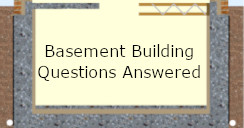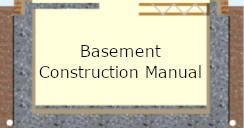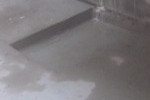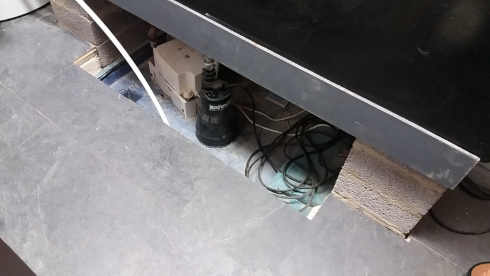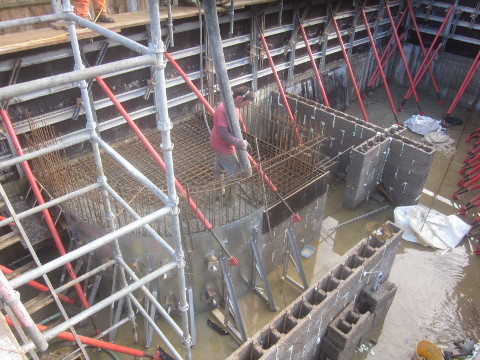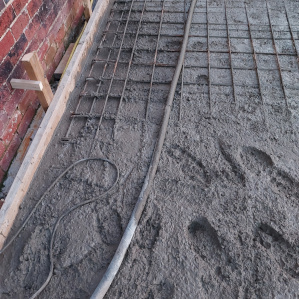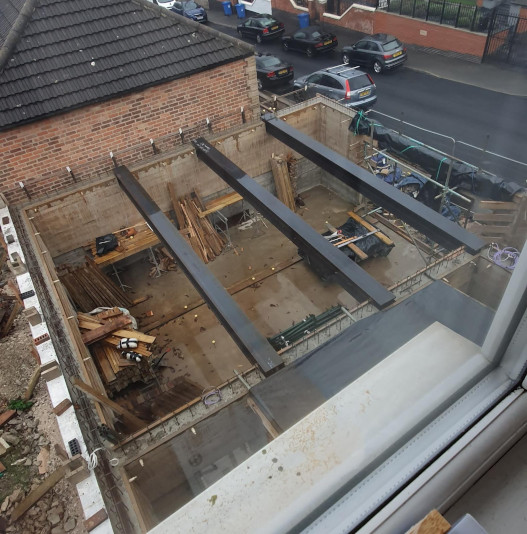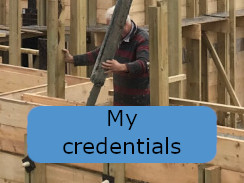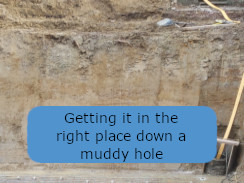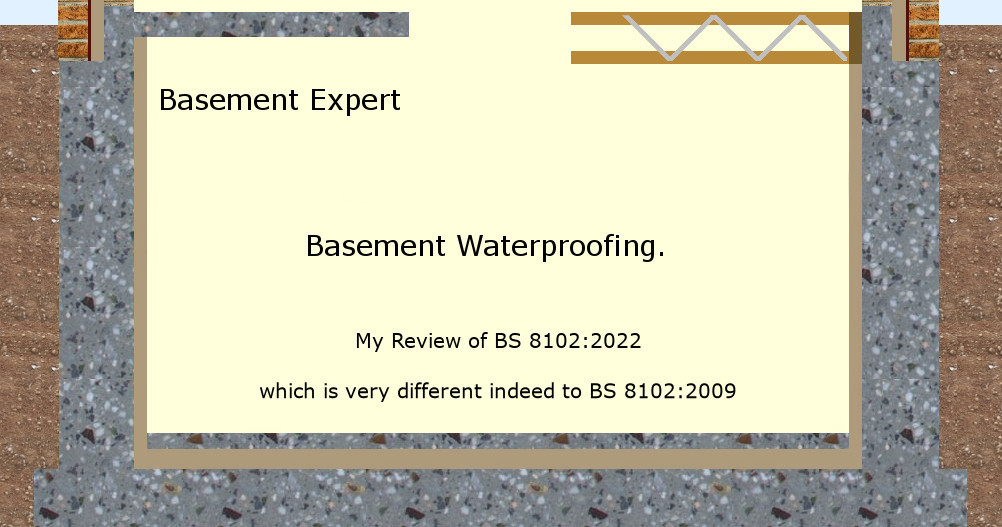
|
Basement waterproofing to BS8102 : 2022.
I already explained on the home page and my page for architects, if occupants get ill because a basement leaked, the law has been broken. There is more than a claim available. There is punishment as well. BS8102:2009 did not work. Contractors learned to game the system and mud got in with rainwater.
Waterproof, reinforced concrete is essential because it cannot be damaged by following-on trades or site operations, such as backfilling, scaffold poles and crane lifts. If the structure cannot be fully waterproofed then repairs must still continue until no leak exceeds 'seepage', because seepage, which means small drips stuck to the surface occasionally coalesce together and run down the wall, is the maximum water permitted to be dealt with by internal drainage. In which case, the basement could never flood neither could enough mud come in to block a pump. Seepage needs to be channelled and removed with a very minor internal drainage system - which should be entirely at the contractor's expense because it is easily avoided. On no account should there be a sump beneath the basement floor slab
I go through the whole Standard here, so that you don't need to buy it. BS 8102:2022 Protection of below ground structures against water ingress - Code of practiceStart of Review. The Standard begins with 3 clauses: (1) foreword, (2) references, and (3) terms and definitions. Definitions. 3.4 damp area area which is slightly wet but no seepage 3.7 fully bonded. bonded, preventing water from tracking from a defect in the membrane to a crack/joint in the structure NOTE This can provide enhanced protection where applied to a suitably impermeable structure because for ingress to occur, a defect in the membrane has to align with a pathway through the structure." It is absolutely clear. Sticky-back membrane should not be used for three reasons.
3.15 seepage slow transmission of water through discrete pathways of a structure NOTE This can also be known as weeping, as defined in ICE publication, Specification for piling and embedded retaining walls. 3.16 tanking application of an appropriate waterproofing barrier to the walls, the base slab and, where relevant, the buried deck of a below ground structure, such that the entire envelope of the structure below ground is protected against water ingress Note A cavity drain membrane is not considered to constitute tanking. An internal drainage system is not a waterproofing measure because it does not prevent water getting through the basement structure. 3.20 waterproof impervious to free water NOTE This can also be known as "watertight". Clause 4 design philosophy 4.1 General Strategies for dealing with all external sources of groundwater, surface/flood water, soil gases and contaminants should be determined from the very earliest stages of the planning and design processes for any project involving below ground structures. This for all basements. New, conversions, going down underneath and huge commercial projects. For new structures, the structural design, overall weatherproofing design, waterproofing design and construction processes sequencing, and buildability of the structure should be reviewed together, as they generally interact. Note New. Not conversions. This is obviously relatively simple for a new house compared to a huge commercial project, and it is clearly beyond the training and experience of a CSSW working for an internal drainage supplier. 4.2 Design team The advice of a geotechnical specialist should be sought on the geology and hydrogeology, the external drainage options and groundwater conditions. A Waterproofing Specialist should be appointed as part of the design team so that an integrated waterproofing solution is created. The waterproofing specialist should: a) be suitably qualified and experienced, commensurate with the type and size of the proposed project; A new basement is a civil engineering project. The waterproofing specialist needs civil engineering knowledge and experience. Civil engineering is different to building because the design may not suit what you later dig down and discover. See 7.2. b) be capable of devising solutions that accommodate the various project constraints and needs with an understanding of construction forms and sequencing; and c) provide the design team with information and guidance that assists with and influences the design, installation and future maintenance of the waterproofed structure. If the RIBA stages are used, a waterproofing specialist should be appointed before the technical design stage at the latest. Please note. The 'Waterproofing Specialist' is not a term defined in clause 3 Terms and Definitions. Neither is the old go-to, a CSSW Surveyor, mentioned anywhere within the Standard. I am perfectly confident that I am suitably qualified and experienced to be the Waterproofing Specialist for a new basement beneath a new house or new house extension. The last sentence in part 4.2, says: Alternatively, a waterproofing specialist may develop an outline design, which is later adopted as part of a client's requirements and developed by a suitably experienced and qualified waterproofing specialist as a Contractor's Designed Portion. Which means it is fine for me to specify, as I do here, my Outline Design because I will enter into a contract to give you my guarantee. 4.3 Principle considerations Whilst relevant, the complexity of this section applies more to complex projects because it is about designing just strong enough. But my approach is more robust than this section suggests. I build with waterproof, reinforced concrete from the bottom to above outside ground level. None of it leaks. None of it can be damaged. It will be just as good in 200 years time. From 4.3.1, Note 3. "The three-dimensional review includes detailed information on the proposed waterproofing system (e.g. the effect that this has on wall base details, laps in membranes and waterstops). Examples of complex geometries are corner details and where the wall adjoins the base slab/foundation; the superstructure; differing floor levels; and windows below ground." Membranes can be pre or post applied; liquid, stickyback, asphalt, clay filled and so on. Also multi coat render if permanently beneath water. I have reproduced 4.3.2, in full, because the causes of defects they list are usually due to either a lack of supervision or just as often difficulties introduced by a poor choice by the architect. 4.3.2 Defects and remedial measures An ideal waterproofing solution would be defect-free. However, it should be taken into account that defects might occur in the waterproofing, which then, if subjected to water pressure, could result in the required internal environment not being achieved. NOTE 1 These defects include the following: a) defects owing to design; b) defects owing to poor workmanship; c) inappropriate use of the materials being used and defects owing to the specific properties of the materials being used; and d) defects caused by follow-on trades and site operations. The reinforced concrete I recommend, if properly supervised from design to completion of pour, solves all 4. NOTE 2 Reference to "defects" does not apply to normal designed flexural cracks or surface crazing in concrete elements but only to cracking, which might need to be locally sealed. The construction methods, installation personnel, materials and protection thereof, used to realize the design, should be such that the defects in all of the above are avoided. The solution is simple. Waterproof, reinforced concrete poured under supervision. Materials should be used in accordance with the conditions and requirements set out in the relevant technical product information and in accordance with the manufacturer's recommendations by personnel trained in their use and application (see also Clause 11). This is worthy of repetition. Materials should be used in accordance with the conditions and requirements set out in the relevant technical product information and in accordance with the manufacturer's recommendations by personnel trained in their use and application This, evidently, is compulsory. Concreting should be supervised. IMPORTANT. For some years now, from all that I have heard, NHBC in particular and many architects, structural engineers, building control officers, other warranty providers and lenders have insisted on a BBA certificate for every product; and if the product has a certificate they tick their box and let you use it. But this line, 'Materials should ...', above, added to a line in 6.2.1 "Relevant manufacturers' product information should be checked to confirm that the system selected is suitable for the structure to which it is to be applied" make it compulsory for any such certificate to be read and understood, fully, before the product is approved. I go through examples of products trusted because they have BBA certificates, but whose BBA certificates have the evidence the product does not do what it is believed to do, on the page for architects here. The potential for defects should be recognized and catered for in the design. Contingency planning for dealing with any localized defects or system failure that arise should be included as part of the overall waterproofing design for the structure (see also Clause 11). In either case, the issue of repairability should be taken into account and the form and feasibility of remedial measures after completion of the project with finishes in place assessed. Figure 1 outlines the principal factors and stages that should be addressed in order to produce a robust waterproofing solution for a below ground structure. The principal issues (shown in boxes) do not necessarily need to be addressed in the order shown but all should be understood and evaluated. NOTE 3 Figure 1 demonstrates that some matters are interrelated and that a degree of iteration might result from a need to address buildability and repairability. 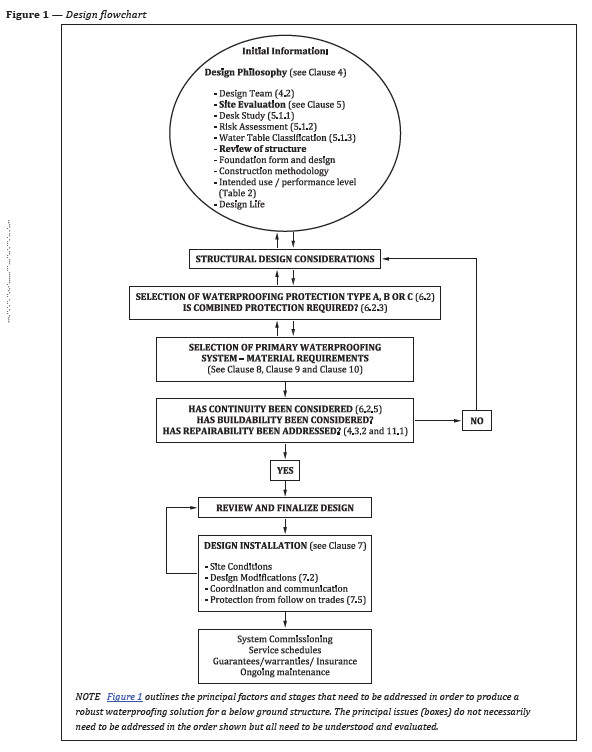
5 Evaluation 5.1.1 Desk Study. Please read my page about soil investigations. 5.1.3 Modular systems, such as twin wall and insulated concrete formwork (ICF) construction should be deemed inherently high risk. See 4.3.2 on defects and remedial viability. There must be a good reason why Glatthaar Keller, as well as every brand and every type of ICF, have been singled out with this warning. I suspect because you don't, or can't, remove the formwork to trace and repair leaks through the poured concrete - which is required to meet this British Standard. 6 Water Resisting Design Before this latest re-write of the Standard it was, or at least it was widely believed, that basement waterproofing required two defences against ingress of water and they each had to be a different type. Whilst this might still be preferable and wise, it is stated in the Standard that two defences are not always required. One defence can be sufficient basement waterproofing, unless the structure could face a pressure of water against it in the future. My own preference would be a concrete structure, proven dry, then waterproof paint as a second defence and vapour barrier all over the inside. 6.2.1 General One, or a combination, of the following types of waterproofing protection should be selected: a) Type A (barrier) protection; b) Type B (structurally integral) protection; and/or c) Type C (drained) protection. There is another noteable change with this re-write in that A used to be external and C used to be internal. Now, Type A, Barrier, might be inside or out and Type C, Drained, can only be outside. Internal drainage can be used if all else fails, but it is not a waterproofing measure. See 3.16. Relevant manufacturers product information should be checked to confirm that the system selected is suitable for the structure for which it is to be applied This was just dealt with at 4.3.2. 6.2.2 "the types of waterproofing systems given in 6.2.1 should be used, subject to their suitability for application and their ability to be repaired" 6.2.3 Combined Protection The use of combined protection in various forms (e.g. Type A + B, Type A + C, Type B + C, Type A + B + C, Type A + A) should be determined where in a single system: a) the assessed risks are deemed to be high (see Clause 5); or b) the consequences of failure to achieve the required internal environment are deemed too high. If the basement could flood if any component of an internal drainage system broke during a terrible storm, the consequences of failure are too high. The structure should have been built better and leaks repaired better. Bearing in mind internal drainage membrane is not a waterproofer, see 3.16, this next phrase would otherwise be confusing. But internal drainage is not a waterproofer. Not a Type C protection. Therefore, this next phrase means if the external drainage might not always protect the structure, the structure should be improved. Although structures with Type C protection are designed to control and manage seepage into a structure, where this is deemed unacceptably high, the water resistance of the structure should be improved prior to the installation of the Type C protection (see Clause 10 for more information on Type C protection). An internal drainage system is to be avoided, not compulsory. In any event, any internal drainage should be designed only to "control and manage seepage". The design team may reject it altogether, meaning that if the contractor cannot reduce leaks so the basement is dry, they must demolish the entire structure and start again - all at their own expense. (But site supervision should have called a halt to bad workmanship before retaining walls were complete). Supervision is mentioned at 9.2.1.1 Crack widths in concrete should be controlled by using the appropriate design of reinforcement, concrete mix specification, construction joint detailing, pour layouts and aspect ratios (and shapes of pours), pour sequences, construction supervision and curing (especially in relation to temperature). The effects of shrinkage cracking due to early-age thermal effects, drying and restraint locations should be taken into account. The Standard gives some examples of how the different types might be drawn. Here are the Type B examples. My method would be drawn like the example in the middle. I have built against concrete piles as in the third example as well. Despite it being suggested in the Standard, the first example, with a concrete kicker (2), would be very difficult to cast successfully waterproof without very difficult repair (see my page about kickers). The suggested waterstop (see my page about joints) in this example is very unlikely to work because water is likely to get past the waterstop through voids in the kicker concrete. Concrete kickers are made with the wrong concrete and are not fully compacted. If a waterstop might work, which it won’t, why is there no waterstop beneath the kicker as well? 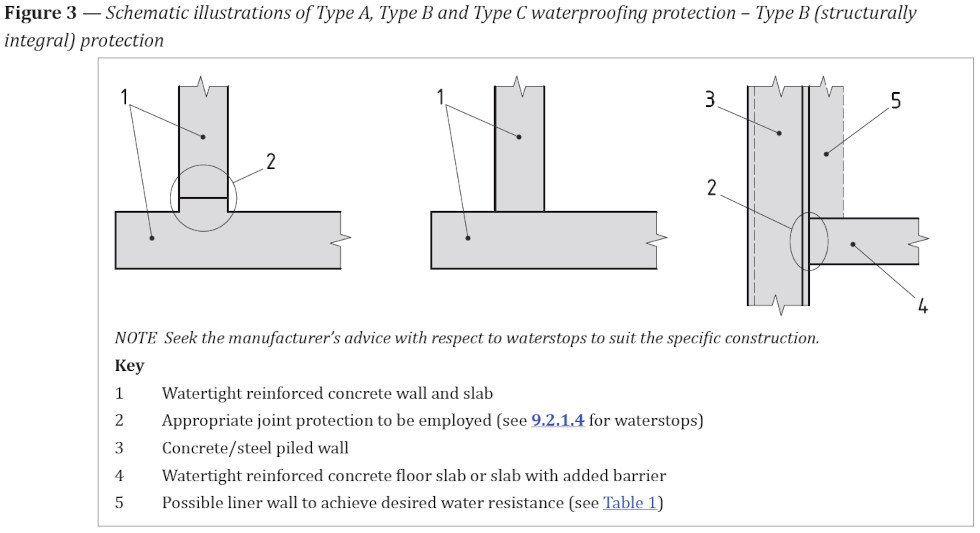
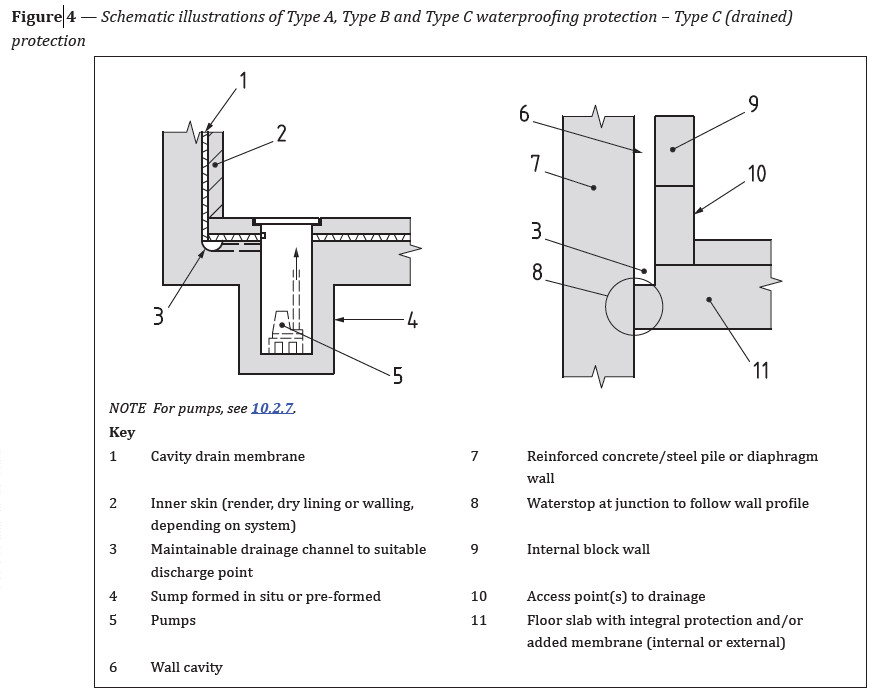
At first glance, you might think internal drainage is allowed. It is allowed but it is not waterproofing. It is, however, a means of protection. It is only allowed if leak repairs reduce all leaks to seepage. Whether the authors intended my interpretation, I don't know. But my interpretation is: The sump and pump on the left has a number of problems.
Whereas the example on the right does not require digging any deeper for a sump. Neither does it require buying any internal drainage membrane or a pump. The Standard does not explain what to do next. This is what I have done.
This shallow tray should be positioned in the plant room and described on the drawing as only an aid to clearing up plumbing spills. On no account and in no way whatsoever should it suggest to the workforce they can cut corners and allow leaks. 6.2.4 Water table classification and required levels of waterproofing performance This section is quite long. It is saying that a great many issues should be considered when designing waterproofing: initial cost compared to potential consequences, unusually high water table, the finishes you want inside, the uses your basement will be put to, the structure cracking in the future, maintenance plan, future upgrades etc. It also says heating and ventilation should be considered as well. I would say that habitable basements should always be ventilated to remove vapour and odours given off by occupants. The Standard allows products that I found never worked satisfactorily, such as sticky-backed membrane stuck to the outside. In a court ruling Outwing v Weatherald the judge said "overlapping self-adhesive membranes cannot be expected to achieve a total or absolute watertight bond capable of resisting penetration by water pressure." The Standard specifically makes the point "e) There are a number of risks associated with not carrying out planned maintenance for structures with Type C protection" However, the old version of the Standard saw some huge leaks in basements. If, for instance, hundreds of tie bar holes were just left, then over the years volumes of soil could be washed in and block the perimeter channel, sump and pump. Planned maintenance must be commensurate with the actual situation on site. If the basement is dry, it has no water removal system to require maintenance. External drainage should be surrounded in geotextile filter membrane with overlaps that do not seal and become waterproof. Drain runs should have rodding eyes. It is necessary to reproduce Table 2 for you here because
Table 2 - Waterproofing protection - Grades of performance for below ground spaces
A) The agreed grade should meet with the client's expectations for the intended use of the below ground space. Reducing the grade could increase the risk of not meeting the expectations of the client for the intended use of the below ground space. B) Seepage (sometimes referred to as weeping) is defined in 3.15. If there is seepage, there is a possibility of mineral deposits forming. C) Damp area is defined in 3.4. D) The scope of this document is limited to detailing the process and best practices that can be followed when creating a waterproof or water-resistant structure below ground. The additional considerations that are required to achieve the required environment are beyond the scope of this document. E) See BS 5454 for recommendations for the storage and exhibition of archival documents. those definitions, again, are
6.2.5 Continuity of waterproof protection The need for continuity in the waterproofing protection should also be determined when selecting a type of protection. In most circumstances, the protection should be continuous (typically from DPC level or 150 mm above ground throughout the below ground structure). Which I understand to mean, if it can be continuous it must be continuous. 'a type of protection'. Singular. No mixtures. No joints or overlaps. 6.4 External sub-surface drainage I would like to be a little more cautious and less adventurous than the Standard. If water can always be drained by gravity through a nice big pipe, at least 100mm diameter, to a ditch, soakaway or somewhere else that can always take that water, then it is a no-brainer. Why make the basement sit in water if it doesn't have to? But the Standard discusses pumping perimeter water away, which I do not like in case of a breakdown. To be fair, it cautions 'where required and achievable' It cautions against a number of other issues including de-watering where you might suck soil from beneath neighbours' foundations. 6.5 Buried decks beneath ground level
Buried decks below ground level should be differentiated from roofs above ground level. NOTE 1 See BS 6229 for recommendations on waterproofing flat roofs. In cases where the below ground structure is fully buried or the substructure extends beyond the superstructure, protection should be provided against water ingress through the roof slab. Such decks should ideally be formed of in-situ reinforced concrete, cast to achieve a fall of 1:80 such that no additional screed is required to achieve falls. When using alternative methods of construction, an unbonded screed should be provided to achieve a fall of 1:80. The substrate movement and cracking and possible implications of damage to the waterproofing layer should be taken into account. Where waterproofing is applied directly to the structural deck, this waterproofing should be fully bonded. You can see steel U shaped bars sticking out of the top of the walls. The deck steel reinforcement was tied to these bars. Many choices of deck waterproofing contain plastic that degrades within 80 years, bitumen and so on. Anything 'applied' should not have a pool of water lying on it permanently and they need the 1:80 fall. Normal or only slightly enhanced structural concrete, such as C35A, might also leak if a pool of water sat on it permanently. My concrete is proven to BS EN 12390 part 8 to be impermeable, even under continuous pressure. BS EN 12390 part 8 is quoted on page 53 of the new BS 8102:2022. The Standard also talks about the risk of The Substrate movement and cracking. Properly designed and properly built with supervision waterproof reinforced concrete will not move or crack. Ever. 7 General Construction Issues 7.1 Site dewatering Site dewatering is expensive. I remember pumps and pipes everywhere when a hospital in Woking was getting a new basement. If your new house needs dewatering to build a basement first it might cost too much. If your dewatering is pulling in silt you might be undermining your neighbour's foundations. Their future subsidence will be your fault and remediation at your expense. 7.2 Unexpected hazards NOTE 1 During the process of excavation or opening up unexpected anomalies in the ground, water tables or existing structures can become apparent. In the event that unexpected conditions are discovered that were not apparent during the site assessment and planning stage, these should be reported to the design team and waterproofing specialist. Completely beyond the ability of a CSSW. 7.3 Structural elements Forms of construction that are to receive below ground waterproofing protection should be structurally appropriate and sufficiently durable. NOTE 1 Examples include the following: a) walls – constructed from: 1) masonry (plain or reinforced brick or block); 2) precast concrete; 3) in-situ concrete, either cast in form (plain, reinforced or prestressed) or embedded walls; or 4) steel or concrete piles in embedded walls; b) base slab – constructed from concrete cast in situ, plain or reinforced, raft or other form; and c) buried deck, where applicable - constructed from reinforced in‑situ concrete, precast concrete with an in-situ topping, or a steel composite slab, as appropriate. a1. Masonry, two skins of blockwork filled with concrete and steel mesh, hollow core blocks filled with concrete and steel bars. Leave all these well alone. Bricks and blocks will leak badly. The mortar dropped into the gap will leak at the bottom, beneath the concrete you add. The two skins of blockwork will fall over. a2. Precast concrete, such as Glatthaar Keller. They fill their twin wall panels but never remove the formwork to look for and fix voids. They may still pour the walls at the same time as the roof as well - which means the wall concrete will settle slightly after a few hours and crack away from the roof concrete. a3. I swear by waterproof reinforced concrete cast inside forms that are removed only after 3 days of curing and cooling down and the surfaces inspected and any blemishes in the concrete chiselled out and filled properly. Plain concrete will crack on cooling and without sufficient steel reinforcement the cracks will not heal. Building a basement for or by the private client inevitably means a few changes as the clients think of something. If you buy prestressed you cannot make any changes. a4. Casting waterproof concrete against concrete piles works very well. My FRP threaded rods save the cost of hiring single-sided formwork. b. A base slab out of reinforced waterproof concrete with sufficient steel reinforcement is simple and it works. c. A deck beneath ground out of reinforced waterproof concrete with sufficient steel reinforcement is simple and it works. Precast with a topping is a lot more likely to leak around the edges under the precast. Especially because this is likely to be beneath outside ground level. Composite steel will never work. They have made an error including it. Composite steel should only be welded to a steel frame with an edge shutter against the end of the corrugated sheet. As soon as it used over a basement you want basement wall steel to be bent into the floor steel, which means your edge shutter is a distance from the corrugated composite sheet and roof concrete will pour out under the corrugations into your basement. You never see this example in promotional literature. 7.4 Continuity in construction NOTE Achieving continuity during the construction phase of any project that involves underground waterproofing is critical to the success of the project. Continuous monolithic waterproof reinforced concrete built and poured under supervision from formation level to above outside ground level. 7.5 Protecting waterproofing Continuous monolithic waterproof reinforced concrete built and poured under supervision from formation level to above outside ground level cannot be damaged by anyone or anything. Anything else probably will be damaged. 8 Type A (barrier) protection 8.2.2.2 Post-applied membranes. Post-applied membranes should be applied to correctly prepared and suitable substrates providing a satisfactory base on which to apply the membrane. Concrete should be free from sharp edges, protrusions and indentions and finished to a true and even surface. Brickwork and blockwork should have flush joints. Particular care should be taken with composite formwork systems where substrates might potentially have an adverse reaction to solvent‑based adhesives and primers formwork release agents might prevent sticky-back membrane sticking, and when backfilling against post‑applied membranes to reduce the risk of damage. To ensure continuity of waterproofing, designers should verify full compatibility between pre- and post-applied membranes. The performance of all sheet membranes relies on effective lap sealing. Lap sealing procedures under all site conditions should follow the manufacturer’s instructions. 9 Type B (structurally integral) protection Clause 9 is About 5 pages long and tries to be thorough, discussing as it does what might be used building a huge shopping mall beneath ground, or an underground station in London. I want to keep just to a new build domestic basement limited to one storey plus, sometimes, a pool or sump in the bottom. In particular, I want to keep to what I do that works 100% of the time. From 9.2.1.1 Crack widths in concrete should be controlled by using the appropriate design of reinforcement, concrete mix specification, construction joint detailing, pour layouts and aspect ratios (and shapes of pours), pour sequences, construction supervision and curing (especially in relation to temperature). The effects of shrinkage cracking due to early‑age thermal effects, drying and restraint locations should be taken into account. 9.2.1.3 Concrete containing water resisting admixtures COMMENTARY ON 9.2.1.3 There is a range of products, generally categorized as water resisting admixtures, which seek various ways to increase the inherent resistance of concrete to water and water vapour. As the mechanisms used each product to achieve these aims are quite diverse, it is not possible in this British Standard to give specific guidance on their use. See Table 9 of BS EN 934-2:2009+A1:2012 for guidance on requirements for water resisting admixtures. I studied waterproofing concrete as best I could during 2012 and at the end I wrote to an academic with my findings. He wrote back to say that at about the same time a working group of 18 members of the Concrete Society had worked on a report "The influence of integral water-resisting admixtures on the durability of concrete" which, at that time, they had just published.
They all contain a powerful plasticiser. I believe the rest to be smoke and mirrors. Since 2013 I have travelled to the USA and Asia many times looking for better and better plasticiser. The one I have now is very powerful indeed. I have another page Waterproof Concrete that goes into more detail. 9.2.1.4 Waterstops The Standard says that a waterstop, there are many types, should be used but it goes on to list many details requiring particular attention if they are to work. In my experience, none get the particular attention. They all fail all of the time. I have a page about joints here. An old Standard, BS 8007 (about the design of water retaining structures), states Construction Joints should have "The surface of the first pour should be roughened to increase the bond strength and to provide aggregate interlock." For years I have found that roughening a suitably steel reinforced joint, cleaning it and keeping it clean till the next concrete arrives works every time. During 2022 an expert from Yorkshire Water who was writing a report on how they could build their water retaining structures to leak less, phoned me to thank me for the information on my web sites that gave him the starting point he needed. 10 Type C (drained) protection An internal drainage system is never continuous from the base of the basement to 150mm above outside ground level, because no one steps up from outside just to allow it to do that. Neither is internal drainage a waterproofing measure. COMMENTARY ON CLAUSE 10 Type C waterproofing protection manages water that penetrates the external shell of a structure, by collecting it in a cavity formed between the external wall and an internal lining/wall. There is permanent reliance on this cavity to collect groundwater seepage and direct it to a suitable discharge point, e.g. drains or a sump for removal by gravity drainage or mechanical pumping. This is the wording where the Standard limits ingress of water to seepage. More ingress than seepage and leak repairs must continue before internal drainage membrane covers the structure to hide bad workmanship and leaks. Clause 10 continues 10.1 Structural aspects The external elements of the structure should be capable of controlling the rate of water ingress so as not to exceed the capabilities of the cavity drain system. Water entering a drained cavity system is regulated by the structure, so defects or elements (see Note 1) that might result in unacceptable leaks should be remedied (see Clause 11) before the system is installed. The external elements of the structure should be capable of controlling the rate of water ingress. defects ... should be remedied ... before the system is installed. 11 Remedial measures There are 24 pages about all the various products people will try to sell you, all the other systems and processes chosen on big, deep structures like the Elizabeth Line, and how to repair them all. But all you need is to do one thing correctly, which means with training and supervision, and your waterproof reinforced concrete will never leak and never need any repair. I typically save my clients 30% the cost of an experienced basement construction team and my clients don't get the problems others get. See my page about leaks here. This is the end of my review of BS 8102:2022.
|
||||||||||||||||||||||||||||||||||||||||||||||||||||||||||||||||||||||
